True to their name, wild roses are extremely robust and beguile with their wonderful fragrance. We introduce you to the 20 most beautiful species of wild roses.
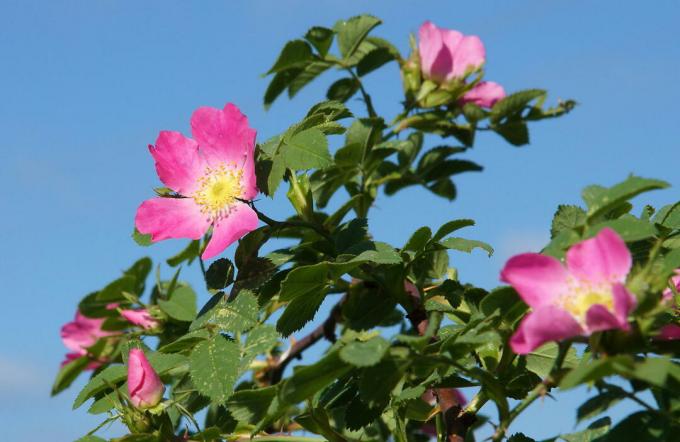
The genus of roses (pink) can look back on a long history of breeding, from which many different varieties have emerged. The origin of this success story was the wonderfully fragrant but extremely prickly wild roses that grow in many parts of the world. As with other rose plants (Rosaceae) - for example with Apple (penalty x domestica), cherry (Prunus avium & Prunus cerasus) or medlar (Mespilus germanica) – the original five-part flower of the wild rose can be seen very well. Nutritious rosehips will later develop from these. Therefore, wild roses are extremely popular not only with gardeners, but also with insects and birds. The low maintenance effort and high disease resistance also speak in favor of planting a wild rose in the garden. The undemanding, vigorous plants are also suitable for stabilizing slopes and embankments, as well as for planting a windbreak or bird hedge. Half-double and double rose varieties, on the other hand, are often no longer fertile and often cannot convince with their robustness.
"Contents"
- Ash rose (Rosa blanda)
- Dog Rose (Rosa canina)
- Meadow rose/ sand rose (Rosa carolina)
- Wedge-Leaf Rose (Rosa elliptica)
- Vinegar Rose (Rosa gallica)
- Pike rose (Rosa glauca)
- Chinese Gold Rose (Rosa hugonis)
- Cinnamon Rose (Rosa majalis)
- Small-flowered rose (Rosa micrantha)
- Soft Rose (Rosa mollis)
- Mandarin rose (Rosa moyesii)
- Tufted rose / Multi-flowered rose (Rosa multiflora)
- Glossy rose (Rosa nitida)
- Alpine Dog Rose (Rosa pendulina)
- Dune Rose (Rosa pimpinellifolia)
- Wine rose (Rosa rubiginosa)
- Potato rose (Rosa rugosa)
- Rose hip rose (Rosa sweginzowii)
- Apple rose (Rosa villosa)
- Virgin rose (Rosa virginiana)
Wild roses come in many different colors and shapes - so it's not that easy to decide on one species. In the following list we give an overview of the 20 best-known and most beautiful wild rose species and their properties.
Ash Rose (pink blanda)
This large-flowered, pink-red wild rose comes from eastern North America and has almost no thorns. It grows to about 300 cm in height and just as wide in old age. The flowering period of the flowers, which are up to 6 cm in size, extends from June to July. The ash rose prefers moist, sunny and stony locations with a neutral to strongly alkaline pH value.

dog rose (Rosa canina)
The dog rose is a native wild rose with cupped, lightly scented, white-pink flowers that forms scarlet hips in autumn. The hardy, heat and drought tolerant dog rose blooms from late May to July. It has an upright growth of up to 300 cm with arching, overhanging, heavily prickly shoots. The dog rose is undemanding in terms of location, it only grows poorly on waterlogged soil. It also thrives well on nutrient-poor and dry soils with a slightly acidic to alkaline pH value. However, permeable, dry to fresh and deep, humus-rich locations are preferred.

Meadow rose/ sand rose (pink carolina)
The meadow rose is also called the Carolina rose because it comes from eastern North America. The small wild rose is just 100 cm high and shows thin, straight spikes on the upright shoots. The pink flowers bloom from July to August. It shows orange-red to yellow foliage in autumn and forms many runners, which are ideal for stabilizing embankments. The optimal location for the meadow rose is moderately dry to moist with a strongly acidic to neutral pH value.
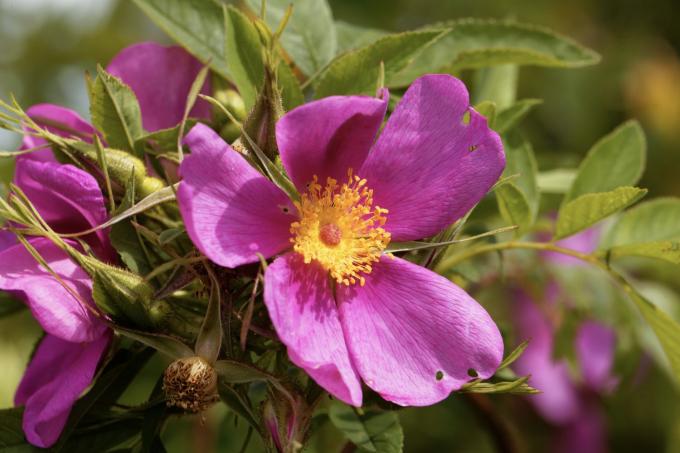
wedge-leaved rose (Rosa elliptical)
Rosa elliptical comes from Central Europe and occurs there in the foothills of the Alps. Closely related to Rosa rubiginosa, the wedge-leaved rose also shares with her the apple scent of the leaves. The light pink flowers of the wild rose form elongated hips in autumn - after the flowering period from June to July. The prickly wedge-leaved rose grows up to 200 cm high and prefers sunny, stony and calcareous locations.
Vinegar Rose (Rosa gallica)
The vinegar rose or apothecary rose is at home in deciduous forests and dry meadows in central and southern Europe. It is an old crop from Roman times - vinegar, rose water or oils were made from the vinegar rose. The pink wild rose that blooms from June to July has a strong fragrance. It grows bushy upright with overhanging shoots up to 120 cm high. The vinegar rose loves humus-rich, well-drained soils, tolerates shade and has good leaf health. It is also suitable for container planting.
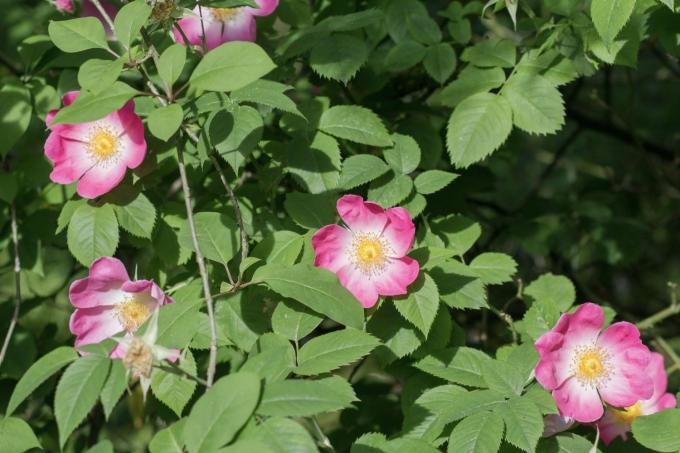
pike rose (Rosa glauca)
This native wild rose is also known as the red-leaved rose and shows cup-shaped, light pink to crimson flowers from June and later a heavy hanging of fruit. The foliage of the bushy, upright rose shimmers bluish in summer. It reaches heights of 150 to 250 cm, is robust and easy to care for. Rosa glauca prefers well drained, dry to moderately moist soil. The pike rose is a local wild rose with no runners.
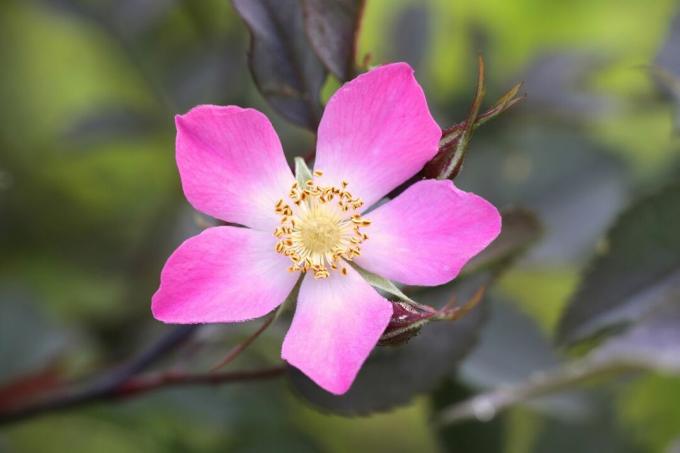
Chinese gold rose (Pink hugonis)
The Chinese gold rose is one of the rare yellow wild roses. It comes from China and flowers as early as May. Black and red rose hips adorn the plant in autumn. It grows broadly bushy, overhanging and reaches heights of growth of up to 200 cm. The Chinese gold rose loves deep, nutrient-rich, moderately dry to moist soil. Due to its origin, it is only partially hardy and needs protection in cold winters.

Cinnamon Rose (Rosa majalis)
The cinnamon rose is a native wild rose species with cinnamon-colored, prickly shoots and a growth height of up to 150 cm. From May to June it forms lightly fragrant, dark pink flowers and later large, spherical rose hips. The cinnamon rose thrives on fresh to wet soil with a high nutrient supply and is extremely hardy.
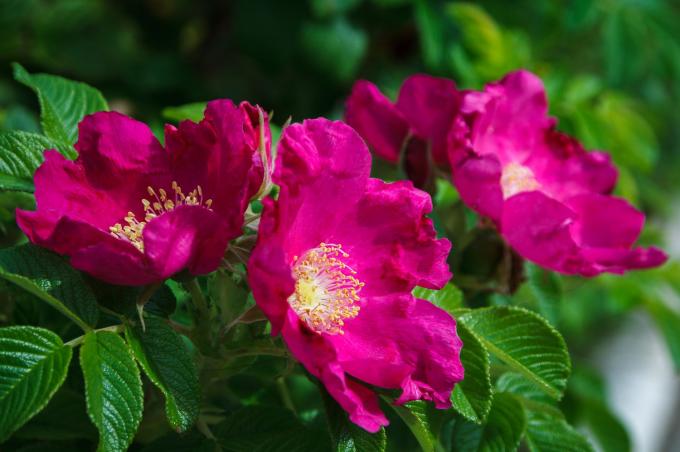
Small-flowered rose (Pink micrantha)
The small-flowered rose is a rare, native climbing wild rose with small, light pink to whitish flowers and a special fragrance. In autumn, spherical to oval shaped, deep red fruits appear. The wild rose grows densely bushy and upright with overhanging shoots. It grows up to 350 cm high, is undemanding, hardy and also suitable for lean and rocky locations.

soft rose (Pink mollies)
The soft rose is widespread in Central Europe and Asia Minor. From June to July, the Soft Rose has 5 cm large, soft pink flowers. The soft, hairy, young leaves give the wild bush rose its name, which is 100 to 150 cm high and has thin, straight thorns. Soft Rose is not demanding on soil, but does best in a sunny spot.
Mandarin Rose (Rosa moyesii)
This red-flowering wild rose is also called red tufted rose and is of Chinese origin. It inspires with its numerous blood-red flowers and conspicuous stamens. Flowering begins in June, bottle-shaped hips are formed in the fall. The hardy mandarin rose is characterized by its sprawling growth and height of up to 200 cm. It grows best in sunny to semi-shady locations with permeable and nutrient-rich soil.

Tufted rose/Multi-flowered rose (Pink multiflora)
The Tufted Rose is a hardy, white wild rose with numerous flowers in panicles found in Japan, Korea and China. It smells strongly of honey when it flowers between June and July and forms plenty of pea-sized rose hips. The wild rose grows up to 300 cm high on average. However, it can climb to a height of 500 cm and forms arching, overhanging, slender, weakly prickly to unreinforced shoots. The tufted rose loves well-drained soils with an acidic to neutral pH. On calcareous soils, however, an iron deficiency manifests itself in the form of yellowing (chlorosis) of the young leaves.
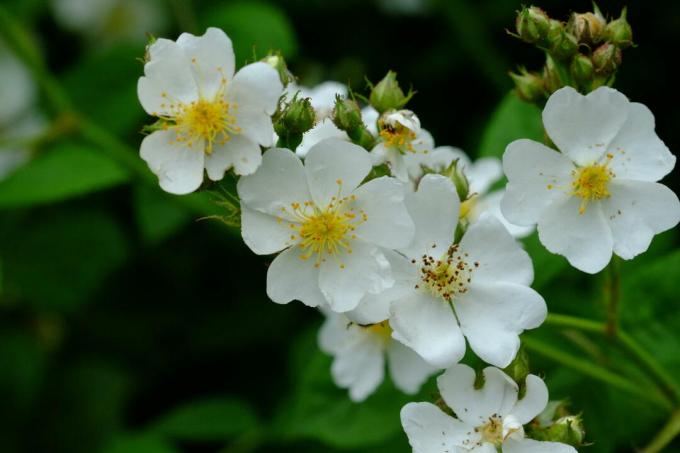
Shine Rose (Rosa nitida)
This rose species is native to eastern North America. The glossy rose is a low wild rose with a height of only 80 cm and strong stolons. It is therefore very well suited for fastening embankments. The glossy, dark green foliage gave the wild rose its name. Its small flowers shine bright pink from June to July. The ideal location for the glossy rose is sunny, moderately dry to moist, with a pH of acidic to neutral. As in Pink multiflora Iron-deficiency chlorosis quickly develops on calcareous soils.
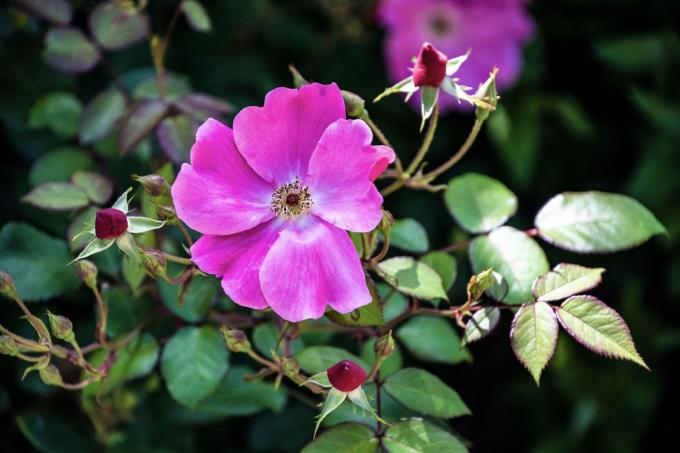
alpine dogrose (Rosa pendulina)
The slightly fragrant wild rose is also known as the hanging fruit rose and shows a compact growth of up to 200 cm in height with overhanging shoots that have hardly any prickles. Its insect-friendly flowers are a strong purple-pink, later developing bottle-shaped, red hips. The robust wild rose species also grows at higher altitudes, is robust, undemanding in terms of location and extremely hardy. Some varieties have already been selected from this species, such as 'Plena', 'Harstadt' or 'Mount Everest'.

dune rose (Pink pimpinellifolia)
The native, white-flowered wild rose grows up to 100 cm high and forms prickly, bristly shoots. The one centimeter large rose hips are conspicuously black-brown in colour. The dune rose is one of the sturdiest wild roses that cannot be harmed by heat, drought, frost or constant wind. The undemanding dune rose loves calcareous locations with a neutral to strongly alkaline pH value on dry to fresh, and also nutrient-poor soil.

wine rose (Rosa rubiginosa)
It is also known as the Scottish briar rose, but is also widespread throughout Germany. The wild rose makes simple, cupped flowers of light crimson pink with dark veining. The leaves smell strongly of apple and wine. The vine rose shows a dense, upright growth with slightly overhanging shoots up to a height of 350 cm. The shoots are heavily thorny, but the vine rose does not form any runners. The Scottish briar grows best on neutral to very calcareous and dry soil.

potato rose (Rosa rugosa)
This hardy, robust wild rose produces large, fragrant flowers. There are different varieties of the Rosa rugosa with lilac to pink or white flowers. It flowers for a long time, from June to October. In autumn, 2.5 cm large, flat-topped rose hips form with an apple-like taste. The potato rose grows stiffly upright up to 180 cm high and forms runners. The plant is undemanding in terms of location, even thriving on nutrient-poor sandy soil. Only the pH value should be considered, because if the lime content is too high, iron deficiency chlorosis occurs.
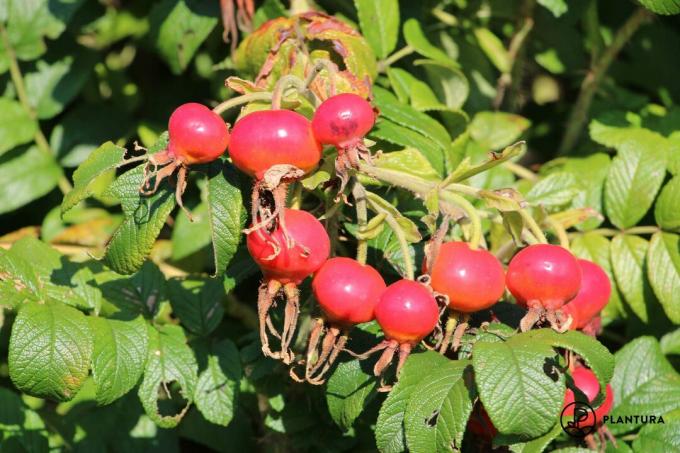
Rose hip rose (Rosa sweginzowii)
The magnificent rosehip rose is an old Chinese wild rose with single, medium-sized flowers in carmine red to pink that bloom from June. The elongated orange rose hips, which are up to five centimeters long, are particularly striking. The heavily thorned, robust magnificent rosehip rose has an arching, overhanging growth of up to 250 cm in height. It prefers deep, permeable and nutrient-rich soils that never dry out completely.

apple rose (Rosa villosa)
Another native wild rose is the apple rose. It's a fragrant wild rose with deep pink flowers and foliage that's just like Rosa rubiginosa smells like apple. The 2.5 cm large, productive rose hips of the apple rose are among the largest of all wild roses. They can be harvested long before the first frost and processed into tasty jam. The apple rose prefers permeable, stony and nutrient-rich soil with a high lime content. It also grows well in partial shade, making it suitable for underplanting tall shrubs and forest edges.
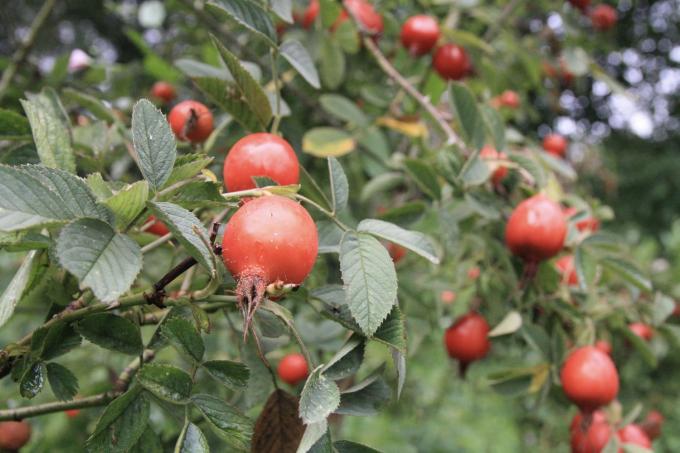
Virgin rose (Rosa virginiana)
Often confused with the Carolina rose, it is a distinct species native to eastern North America. Its five centimeter large pink flowers are fragrant and bloom in late July to August. The frost hardy Virginia rose forms runners and is about 150 cm high and wide. It thrives on all moderately dry to fresh locations between acidic and neutral pH.

Wild roses produce vitamin-rich fruits after flowering rosehips. In our special article on Planting of rosehip roses Find out everything you need to know about your requirements and care measures.
